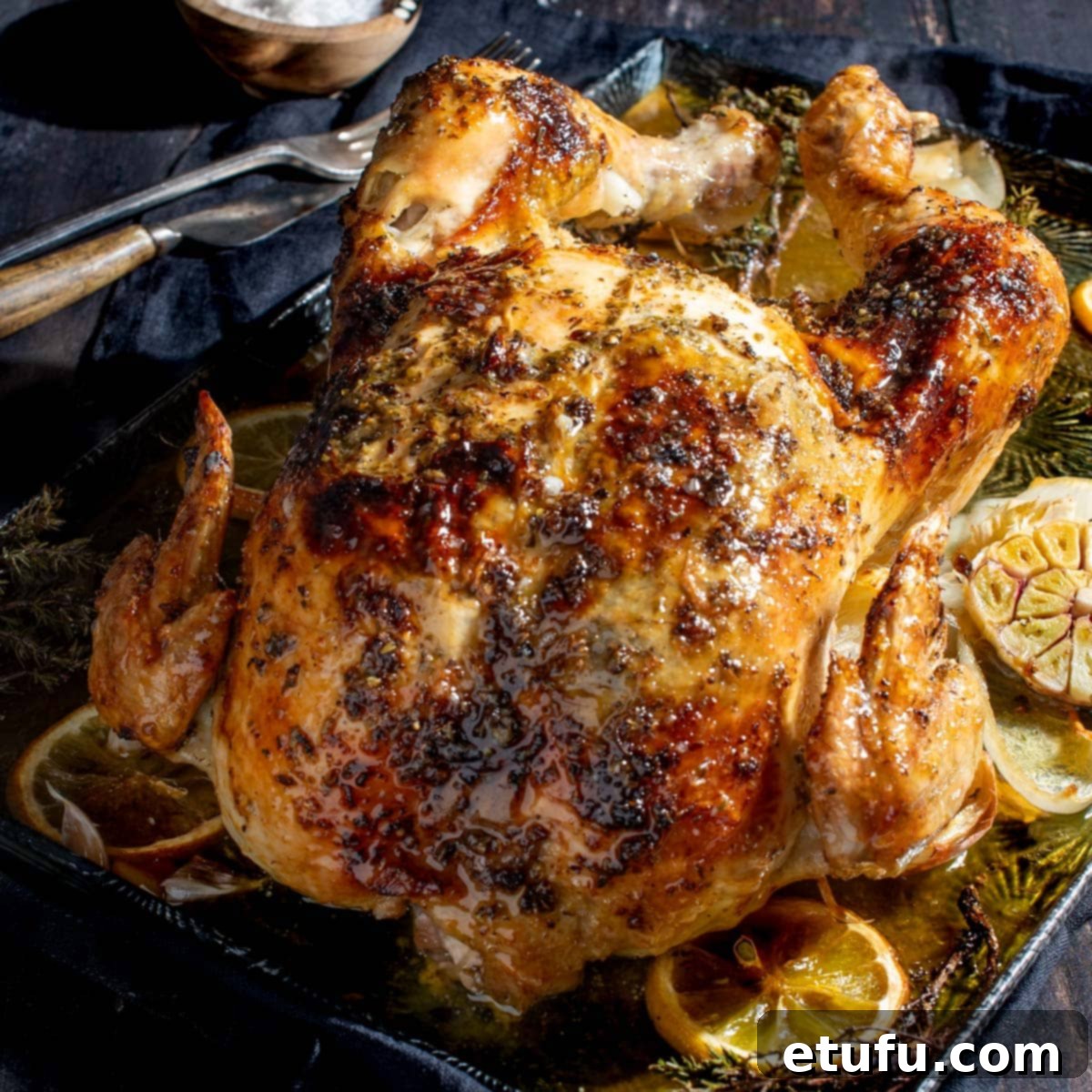Ultimate Greek Roast Chicken with Crispy Skin & Garlic Herb Butter
Embark on an epicurean adventure to the sun-drenched shores of Greece, where culinary excellence blossoms from the simplest, freshest ingredients. It’s a philosophy that celebrates the inherent goodness of natural produce, transforming a handful of staples into extraordinary dishes bursting with flavor. This commitment to quality and simplicity is at the heart of our delectable Greek roast chicken recipe, promising to transport your taste buds straight to the Mediterranean.
Our recipe for a simple yet profoundly satisfying roast chicken truly embodies these cherished Greek principles. With a golden, irresistibly crispy skin giving way to a supremely juicy interior, every bite is infused with the iconic flavors of oregano and the vibrant zest of fresh lemon. It’s a dish that captures the very essence of a sunny Greek holiday, bringing warmth, comfort, and authentic Mediterranean charm right to your dinner table.
“Cooked this the other night with Greek lemon rice. No leftovers!”
– JoJo (Pinterest)

Why This Greek Roast Chicken Recipe Will Become Your Go-To
Contrary to popular belief, preparing a perfectly roasted chicken is far from complicated. In fact, it stands as one of the most straightforward and rewarding dishes you can master, even if you’re a complete novice in the kitchen. We promise that with just a few minutes of mindful preparation, you can let your oven do the heavy lifting, delivering a spectacular meal with minimal fuss.
This comprehensive guide is designed to demystify the art of roasting, equipping you with the know-how to achieve culinary perfection. We’ll delve into:
- **The Secrets to Crispy Skin:** Unlocking that coveted golden, crackling skin requires the right preparation techniques, precise oven temperatures, and impeccable timing. We’ll break down each element to ensure your chicken achieves that delightful crunch.
- **Mastering the Juiciest Interior:** Our foolproof method involves infusing a fragrant herby garlic butter directly under the chicken’s skin. This technique, while sounding gourmet, is incredibly simple to execute and guarantees an unbelievably moist and flavorful bird. We’ll guide you through it step by step.
Once your beautifully prepared chicken is nestled in the oven, you’re free to sit back, relax, and let the enticing aromas fill your home as the heat works its magic. The result? A stunning centerpiece that’s as impressive as it is delicious.
Special Note for Our Readers: This blog post is meticulously crafted to be highly accessible for those embarking on their first chicken roasting journey. We’ve included an abundance of detail, along with clear, step-by-step photos to illustrate every stage of the process. If you’re an experienced cook confident in your roasting abilities, feel empowered to navigate directly to the streamlined recipe card located at the bottom of this post for a quick reference.
Discover Greece: Fast Facts & Culinary Philosophy

| Location | Greece is strategically located in southeastern Europe, gracefully positioned on the southern tip of the Balkan Peninsula. It shares its northern borders with Albania, North Macedonia, and Bulgaria, and its northeastern frontier with Turkey. The country is beautifully embraced by the Aegean Sea to the east, the vast Mediterranean Sea to the south, and the tranquil Ionian Sea to the west, defining its iconic insular geography. |
| Capital | Athens, a city renowned for its profound historical significance and as the birthplace of democracy, philosophy, and many Western cultural tenets. |
| Language | The official and national language spoken throughout Greece is Greek, one of the oldest recorded living languages. |
| Population | With a vibrant population hovering around 10.4 million people, Greece is a nation rich in cultural heritage and natural beauty. |
| Trivia | Intriguingly, certain ancient sites across Greece implement strict prohibitions against wearing high heels. This unique regulation is in place to safeguard the delicate ancient stone structures, some dating back to the fifth century BC, preserving these invaluable historical treasures for future generations. |
Greek culinary philosophy is deeply rooted in the concept of “filoxenia” (hospitality) and a profound respect for nature’s bounty. The Mediterranean diet, celebrated globally for its health benefits, originates here, emphasizing fresh, seasonal vegetables, legumes, olive oil, fish, and lean meats like chicken. The magic often lies in simple preparations that allow the quality of each ingredient to shine through, rather than masking flavors with complex sauces. This approach is perfectly showcased in our Greek roast chicken, where the natural taste of the chicken is enhanced by aromatic herbs and bright citrus, creating a harmonious and unforgettable meal.
What Makes Our Greek Roast Chicken Irresistible?
- **Authentic Greek Flavors:** This recipe is a vibrant symphony of classic Greek-style flavors, achieved with just a handful of staple ingredients. The aromatic blend of oregano and lemon creates a truly evocative taste of the Mediterranean.
- **Unmatched Juiciness from Within:** The secret to an incredibly moist and tender chicken lies in our unique application of herby garlic butter, tucked directly under the skin. It’s a technique that’s far simpler than it sounds but delivers profoundly delicious results every time.
- **The Secret to Crispy Skin Unveiled:** Crack the code to achieving that highly sought-after, golden-brown crispy skin. Our specific preparation methods and optimized oven settings guarantee a delightful crunch that will elevate your roasting game.
- **Perfect for Every Skill Level:** Whether you’re a kitchen novice or a seasoned chef, this recipe is incredibly approachable. It requires only a few minutes of active preparation, allowing the oven to perform the vast majority of the culinary work.
- **Crispiness Maximized:** We deliberately avoid drenching the chicken in excessive olive oil or other liquids during roasting. This careful approach is key to ensuring the skin achieves its maximum potential for crispiness, providing a satisfying texture contrast to the tender meat.
- **Versatile for Any Occasion:** Elevate your Sunday dinner with a Mediterranean twist, or impress guests at special gatherings. This Greek roast chicken is a versatile and elegant centerpiece, equally suitable for a comforting family meal or a festive celebration.
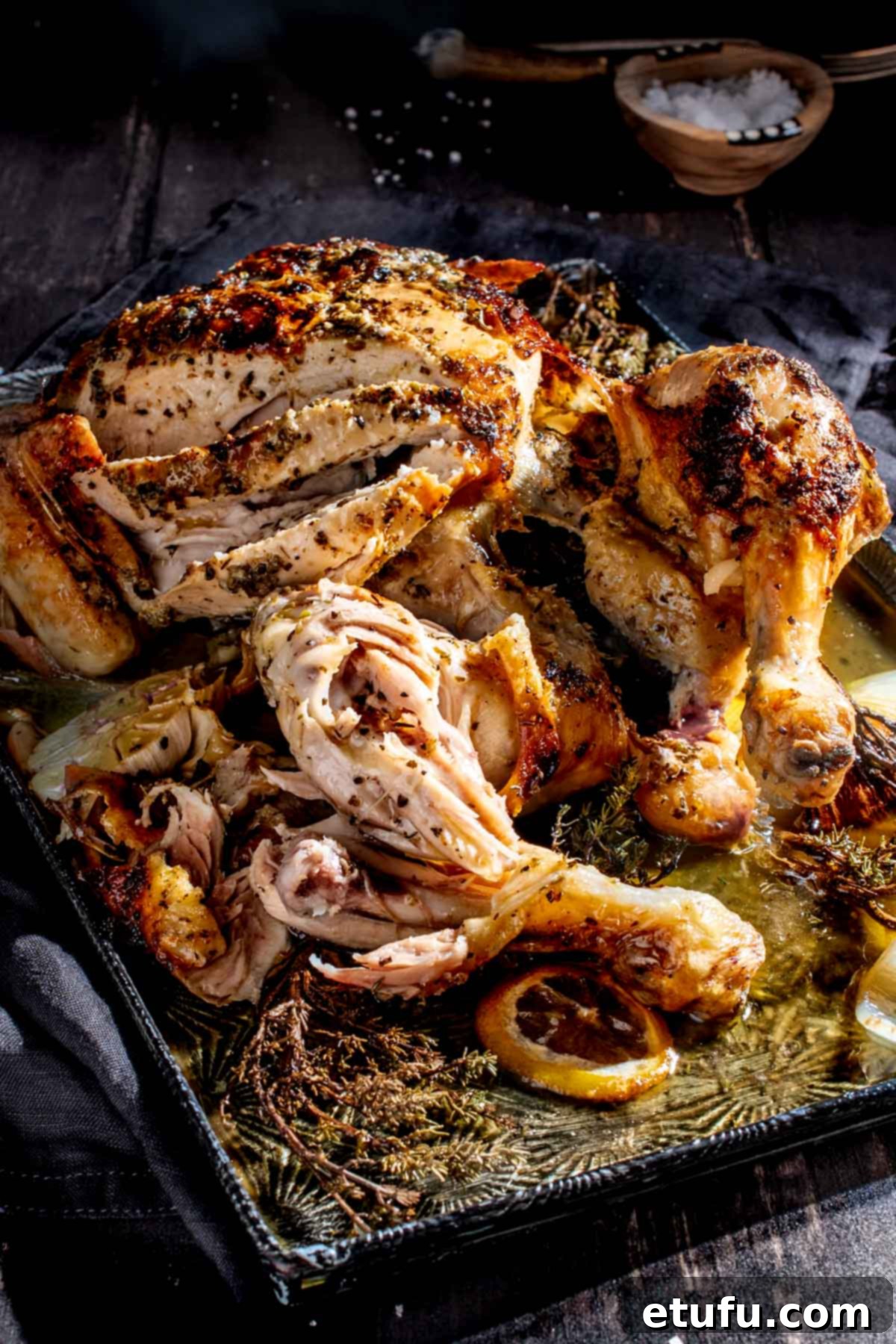
Essential Ingredients for Your Authentic Greek Roast Chicken
**For a complete list of ingredients and precise measurements, please refer to the detailed recipe card at the conclusion of this post.

Choosing the Perfect Whole Chicken
For this recipe, the ideal choice is a substantial, whole chicken, generally weighing around 1.9kg (approximately 4.2lb). Should your chicken be notably smaller or larger, remember to adjust the quantity of compound butter accordingly to ensure thorough flavor infusion.
When selecting your chicken, pay close attention to the integrity of its skin. It should be fully intact, free from any tears or significant punctures. This detail is paramount, as a flawless skin ensures that the aromatic butter stuffing remains securely tucked underneath throughout the roasting process, maximizing flavor and moisture. We’ve rarely encountered issues with this, as most store-bought chickens are perfectly suitable.
If your chicken includes giblets, you have the option to either discard them or retain them for future culinary endeavors, perhaps for a rich stock or gravy, by simply freezing them for later use. Always bring your chicken to room temperature for about 30 minutes before roasting, as this promotes more even cooking.
The Magic of Unsalted Butter
We specifically recommend using unsalted butter for our compound butter. This choice provides you with complete control over the overall saltiness of your dish, allowing you to season it precisely to your preference without accidental oversalt. If you only have salted butter, reduce the added coarse sea salt.
Achieving the Perfect Butter Consistency:
When you’re preparing the compound butter (the herby garlic stuffing), it’s crucial for the butter to be soft and pliable, but definitively not melted or runny. This semi-soft state makes it effortlessly easy to thoroughly mix in the fresh herbs, garlic paste, and seasonings, creating a homogeneous blend.
Once your compound butter is perfectly mixed, its consistency should still be firm enough that you can easily pinch off small pieces. This is essential for neatly tucking and spreading it under the chicken’s skin without it oozing out prematurely. If you happen to soften your butter a little too much—perhaps a microwave mishap—don’t fret! Simply incorporate the remaining ingredients and then pop it into the refrigerator for a short spell until it regains that ideal pliable texture.
Aromatic Greek Herbs: Oregano & Thyme
Oregano is not just an ingredient; it’s the very soul of authentic Greek flavor, and in this Greek roasted chicken recipe, it undeniably takes center stage. Its robust, earthy, and slightly peppery notes are indispensable for capturing that signature Mediterranean taste.
While fresh oregano offers an intense aromatic experience, we typically opt for dried oregano, as it is more readily available and equally potent. However, if you have access to fresh oregano, feel absolutely free to use it for an even brighter flavor profile!
Alongside oregano, we introduce another beloved Greek herb: fresh thyme. Its subtle, earthy, and slightly minty undertones beautifully complement the lemon and garlic. Should fresh thyme be unavailable, fresh rosemary makes an excellent substitute, offering a similar aromatic depth. Alternatively, dried versions of either herb will work wonderfully.
The Art of Seasoning: Coarse Sea Salt
Choosing coarse sea salt for seasoning your chicken offers a distinct advantage: superior control over the saltiness. Unlike fine-grained table salt, which disperses rapidly and can lead to accidental oversalt, coarse sea salt allows for a more deliberate and measured application, ensuring your chicken is perfectly seasoned every time.
Beyond its controlled application, the coarse texture of sea salt plays a critical role in achieving that sought-after crispy skin. As the chicken roasts, the salt efficiently draws moisture from the skin’s surface, promoting a crisp, golden exterior that is simply irresistible.
The Flavor Foundation: Onion and Garlic Trivet
What’s the true purpose behind placing your chicken on a simple ‘trivet’ of garlic and onions? This seemingly minor step is actually a culinary powerhouse, contributing significantly to the success of your roast chicken.
Firstly, elevating the chicken slightly from the base of the roasting dish allows for optimal air circulation around the entire bird. This ensures more even cooking and is a critical factor in developing that desirable crispy skin on all sides.
Secondly, as the chicken roasts, the heat gently coaxes out the rich, sweet, and savory flavors from the garlic and onions beneath. These aromatic compounds infuse upwards, subtly perfuming and enriching the chicken with a deeper, more complex taste profile.
Thirdly, and perhaps most enticingly for many home cooks, these beautifully roasted onions and garlic heads are pure liquid gold if you plan to create a luscious gravy from the pan juices. They provide an incredible flavor base that will transform your sauce from good to unforgettable.
For best results when quartering your onions, trim a small amount off both ends of each quarter. This ensures they sit flat and stable on the roasting dish, creating a perfectly level surface for the chicken to rest upon. There’s no need to meticulously peel the onions; simply remove any very dry or loose outer layers.
Zesty Lemon: Freshness and Acidity
Lemon is a cornerstone of Greek cuisine, celebrated for its ability to brighten flavors and cut through richness with its refreshing acidity. In our Greek roast chicken, lemon plays a dual role: half is nestled within the cavity to infuse the meat with subtle citrus notes from the inside out, while the other half is squeezed over the exterior just before roasting.
This external application of lemon juice adds a final layer of zing, but it’s important to apply it sparingly. Drenching the chicken would hinder the skin’s ability to crisp up. The goal is a light kiss of freshness that complements the herbs and garlic without compromising texture.
Step-by-Step Guide to Roasting Your Greek Chicken
- Prepare the Chicken: Remove your whole chicken from the refrigerator approximately 30 minutes before you intend to begin preparation. This crucial step allows the chicken to come closer to room temperature, ensuring more even cooking throughout.
- Note Weight for Cooking Time: Before proceeding, accurately note the weight of your chicken. This measurement is essential for precisely calculating the required roasting time later in the process.
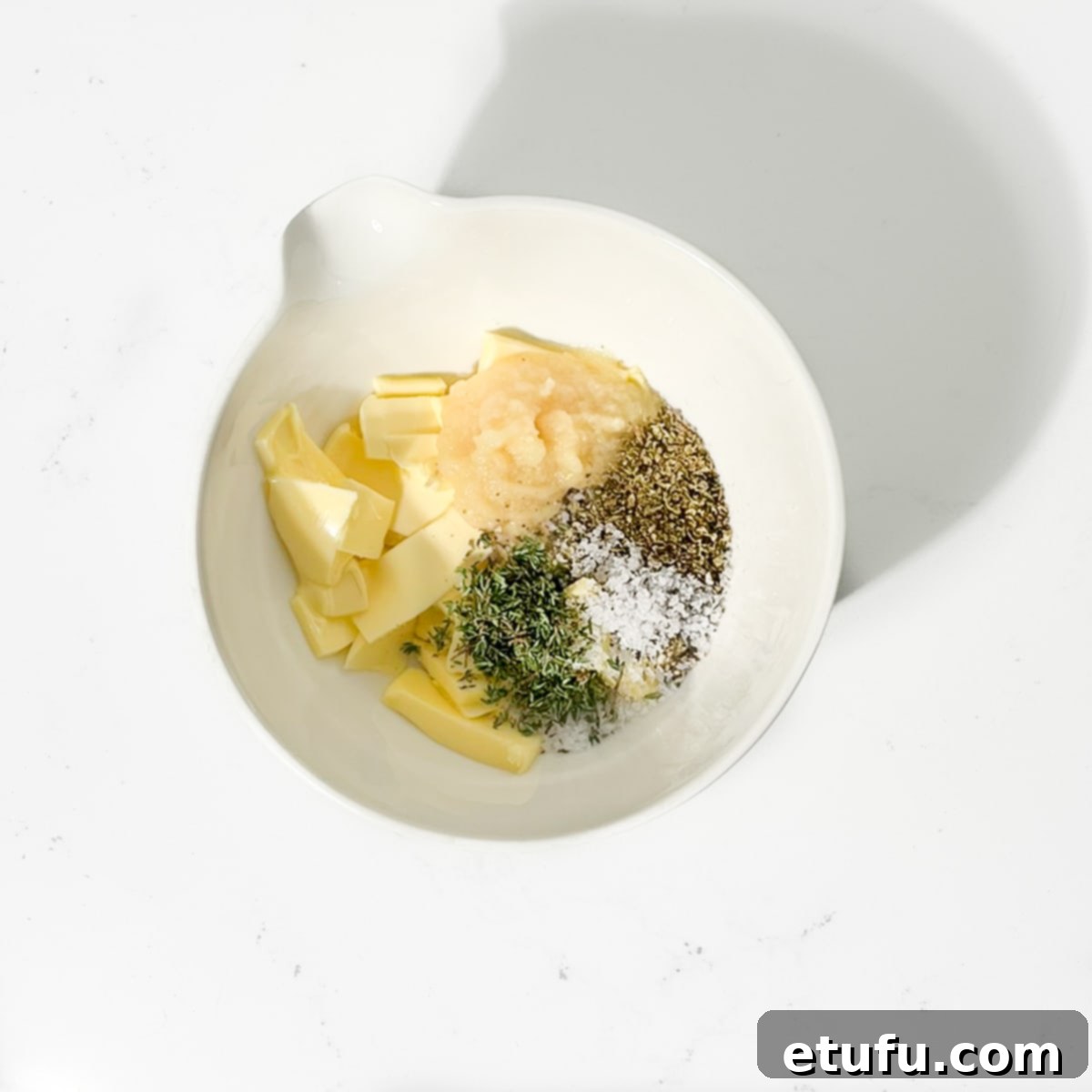
- Craft the Compound Butter: In a medium-sized bowl, combine the softened unsalted butter, garlic paste (or finely minced fresh garlic), dried oregano, freshly chopped thyme, a pinch of coarse sea salt, and a dash of black pepper.
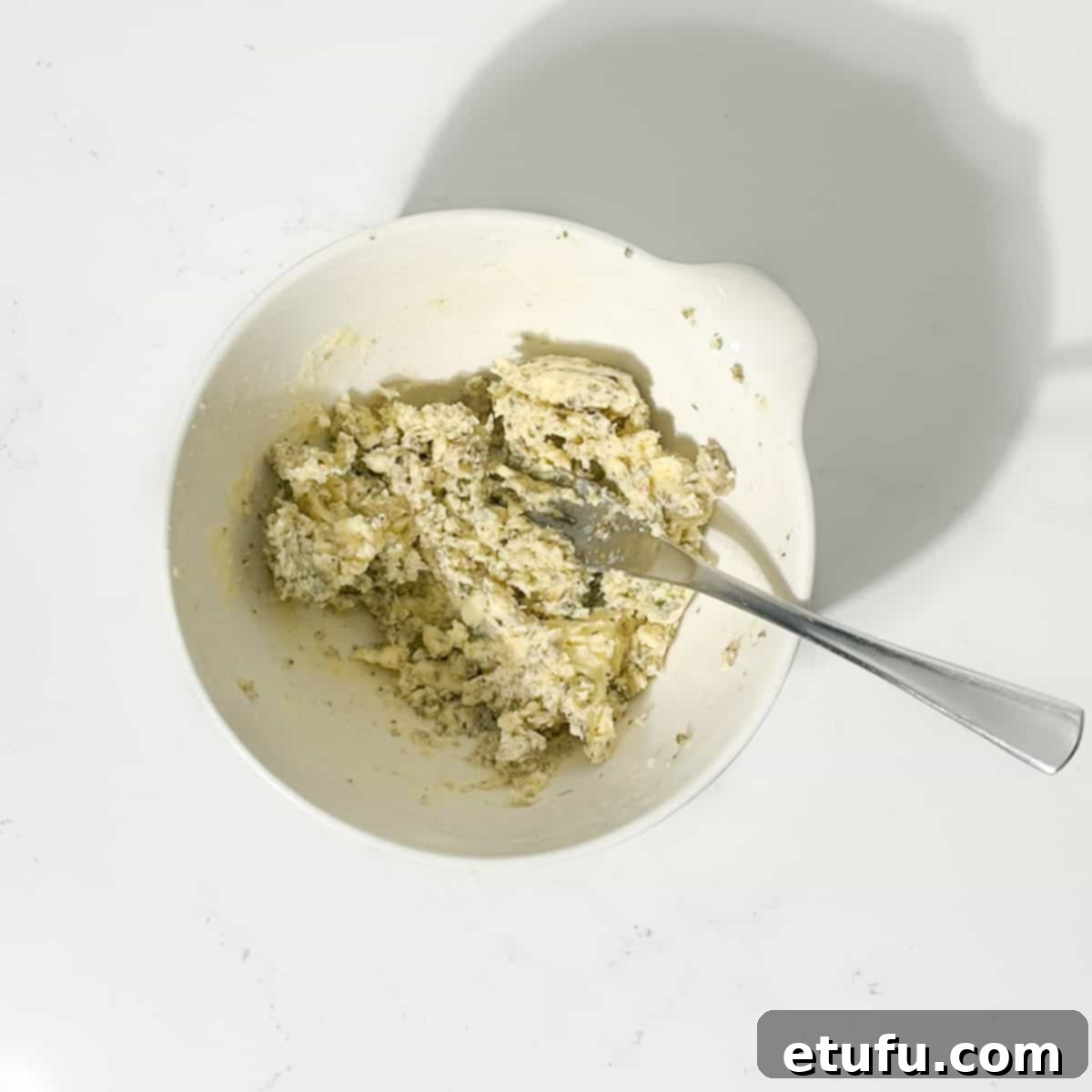
- Mix the Butter: Using a fork, thoroughly mash and blend all the ingredients together until they are completely combined and uniformly distributed. Set this fragrant compound butter aside.
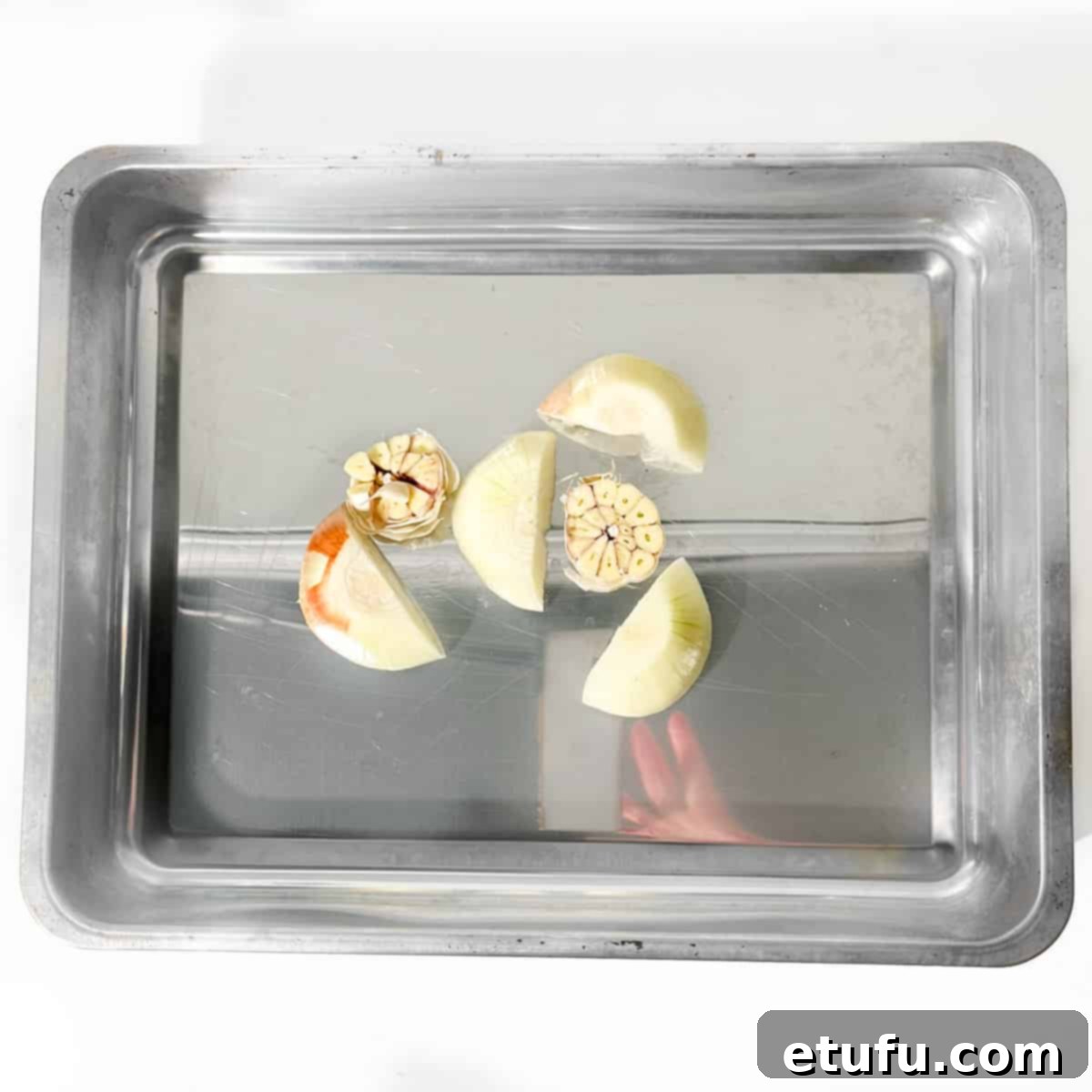
- Prepare the Trivet: In a large roasting pan or on a sheet pan, artfully arrange the quartered onions and halved garlic heads to create a stable, aromatic ‘bed’ upon which your chicken will rest. Ensure the onions are flattened on both sides for stability.
- Preheat Your Oven: Preheat your oven to a robust 220°C (430°F). Achieving the correct initial temperature is vital for crisp skin.
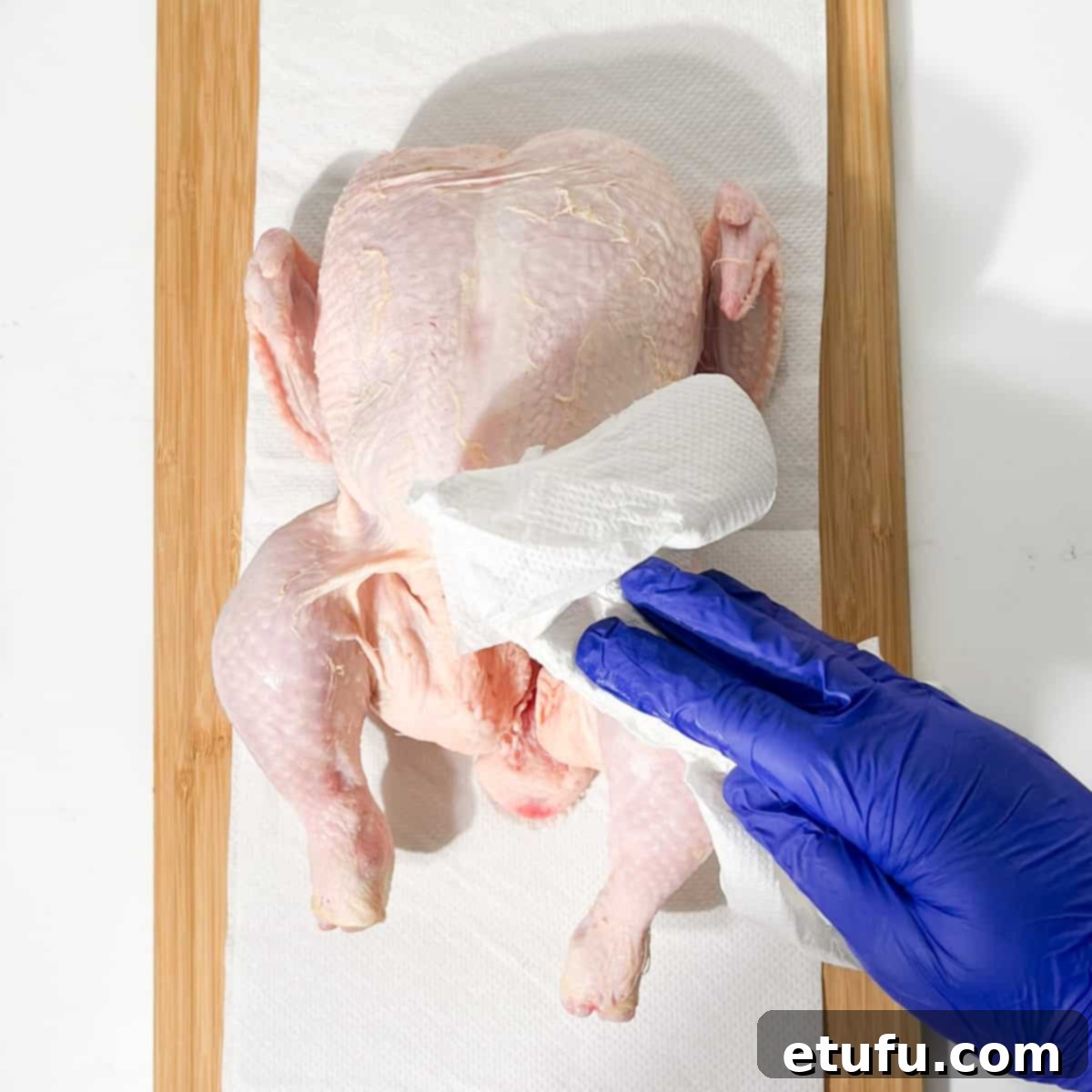
- Thoroughly Dry the Chicken: Carefully remove the chicken from its packaging and place it on a layer of clean kitchen paper. Using additional paper towels, gently but thoroughly pat the entire bird bone dry. This step is absolutely crucial for achieving that coveted, extra-crispy skin.

- Loosen the Skin: To facilitate the placement of the butter under the skin, gently loosen the skin from the chicken’s flesh. Use a large spoon or a spatula to carefully slide between the meat and the skin, separating them as you work your way around the upper half of the bird’s body. Exercise caution to avoid tearing the skin during this process.
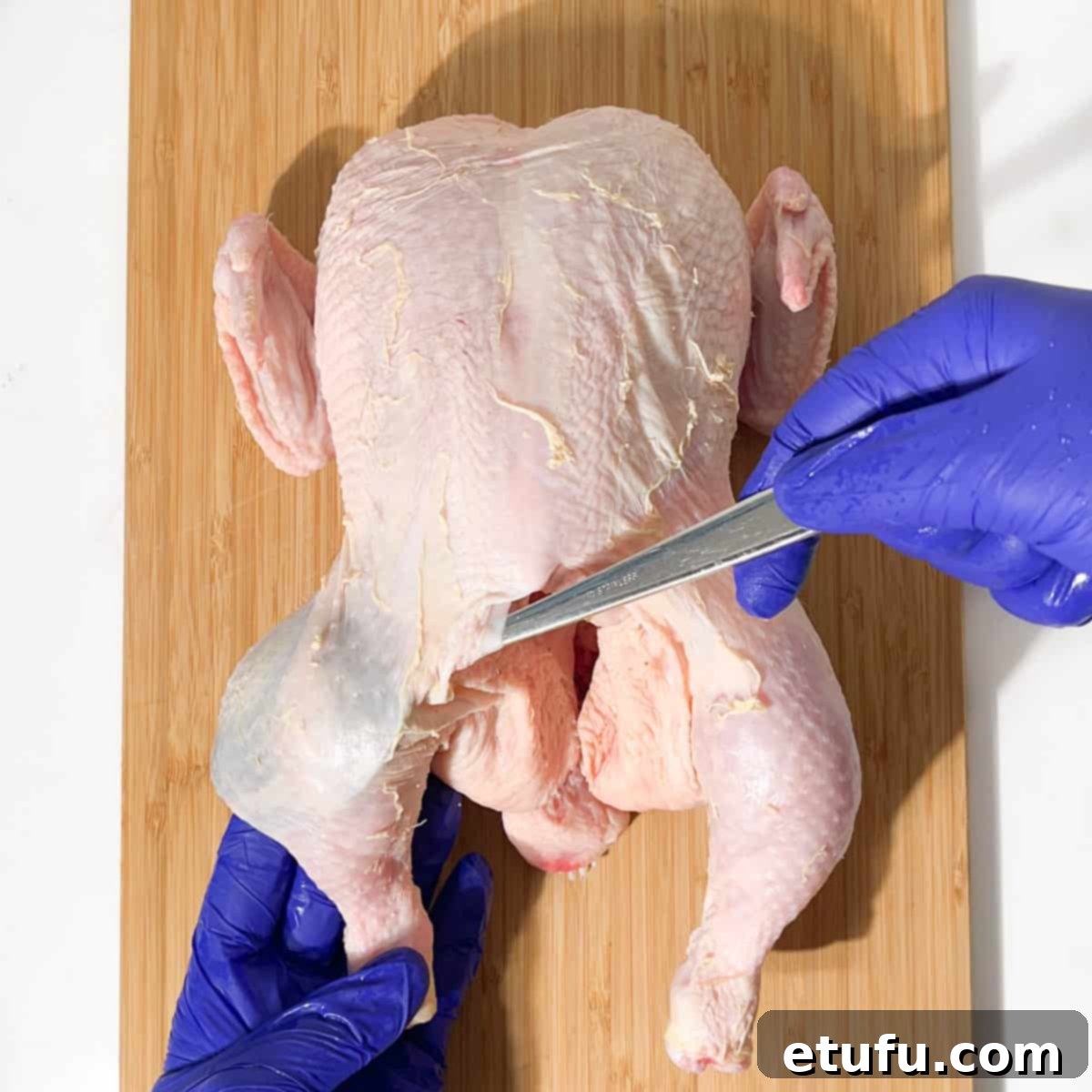
- Loosen Leg Skin: Repeat the loosening process for the chicken legs. You should be able to find a natural entry point near the looser skin around the chicken’s cavity. (Note: There is no need to loosen the skin on the underside of the chicken.)
- Reserve Butter: Set aside approximately one-quarter of your prepared compound butter. This reserved portion will be used to generously coat the exterior of the chicken later.
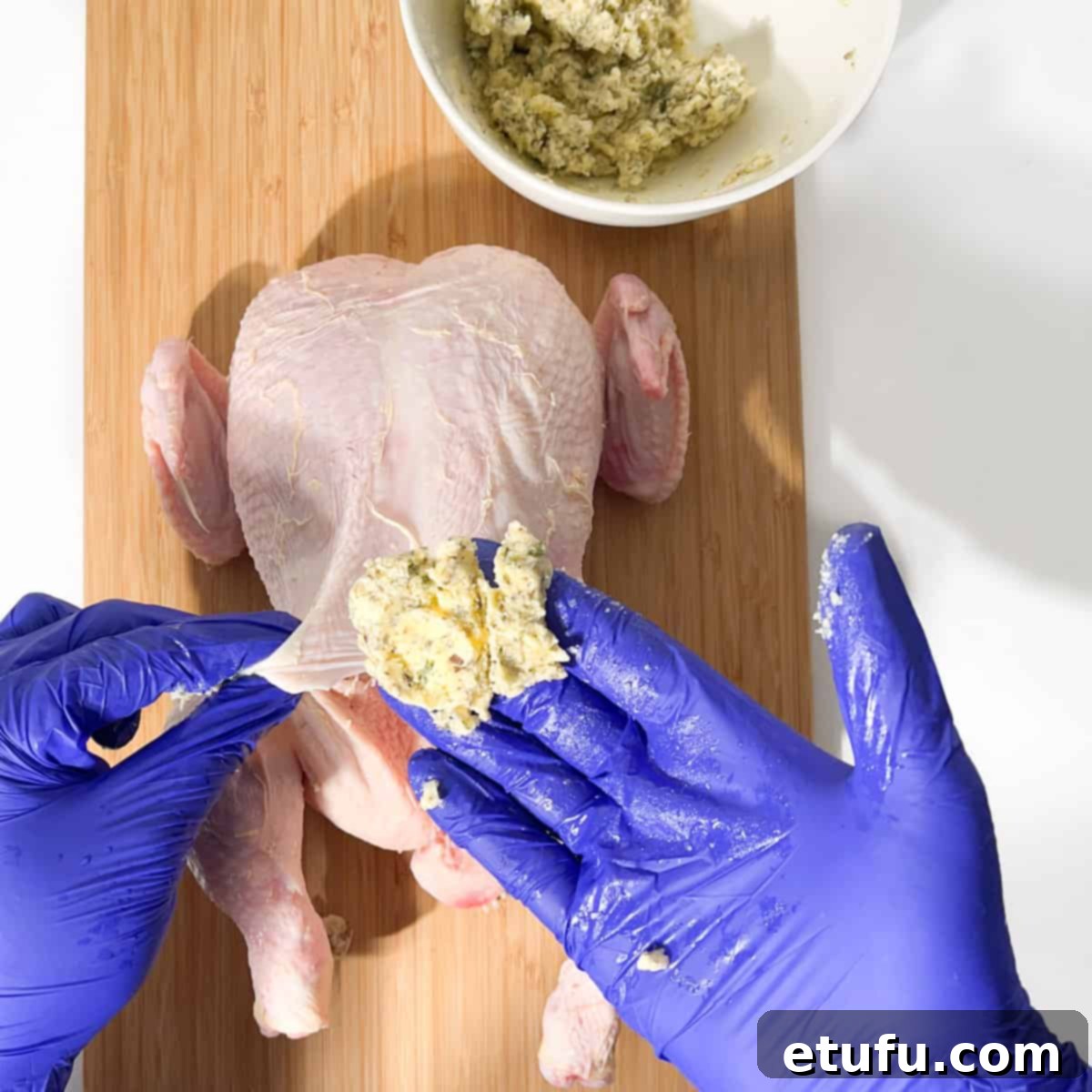
- Portion Under-Skin Butter: From the remaining compound butter, pinch off small, manageable pieces, roughly two teaspoons’ worth at a time, using your fingers.
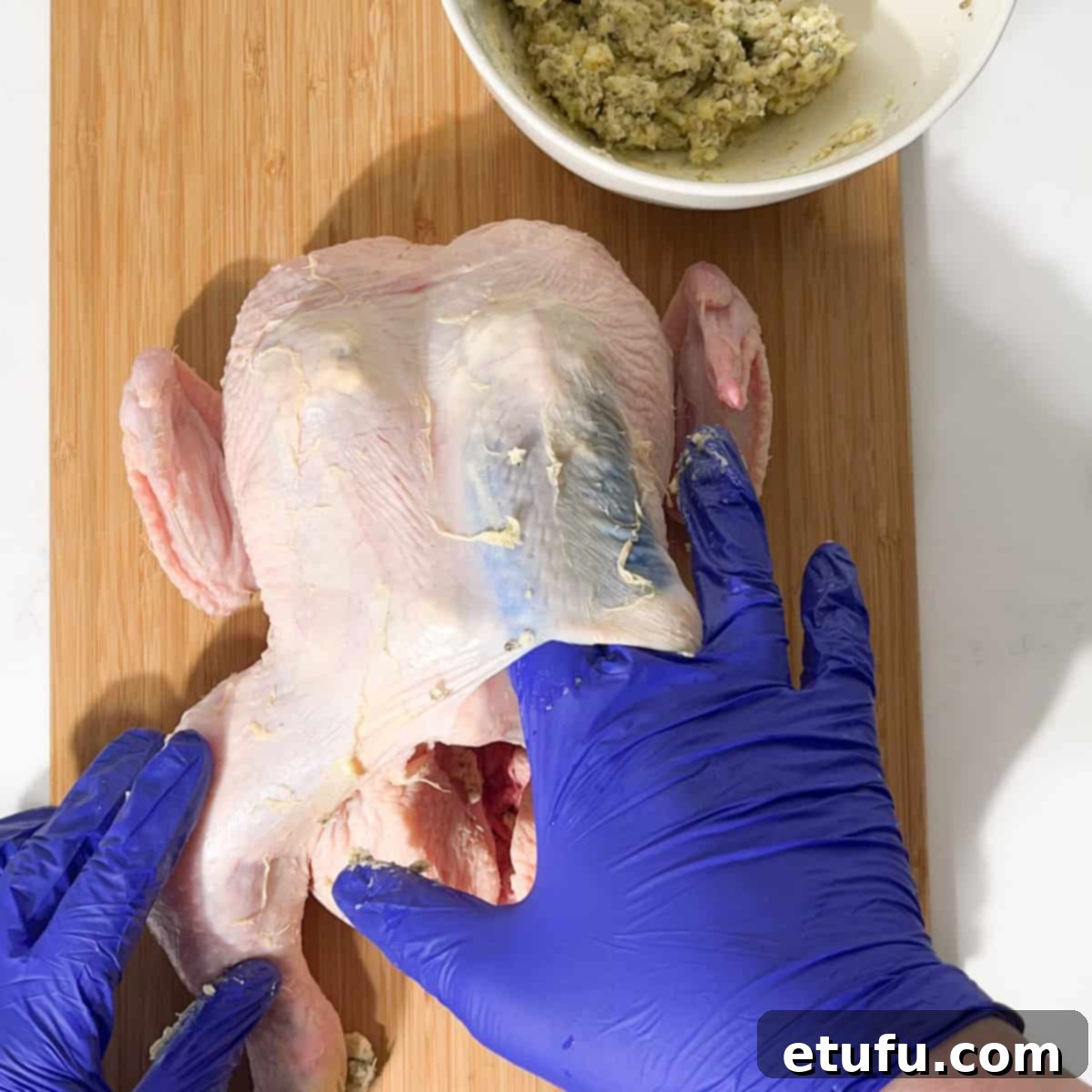
- Apply Butter Under Skin: Gently push these dollops of butter underneath the loosened skin, working them upwards towards the top of the chicken breasts. Continue placing more dollops until you have evenly distributed a few across the largest surface areas of the chicken’s breast and thigh regions.

- Distribute Butter: From the outside, gently press down on the chicken’s skin to massage and spread the butter underneath, flattening it out slightly to ensure an even coating over the flesh.
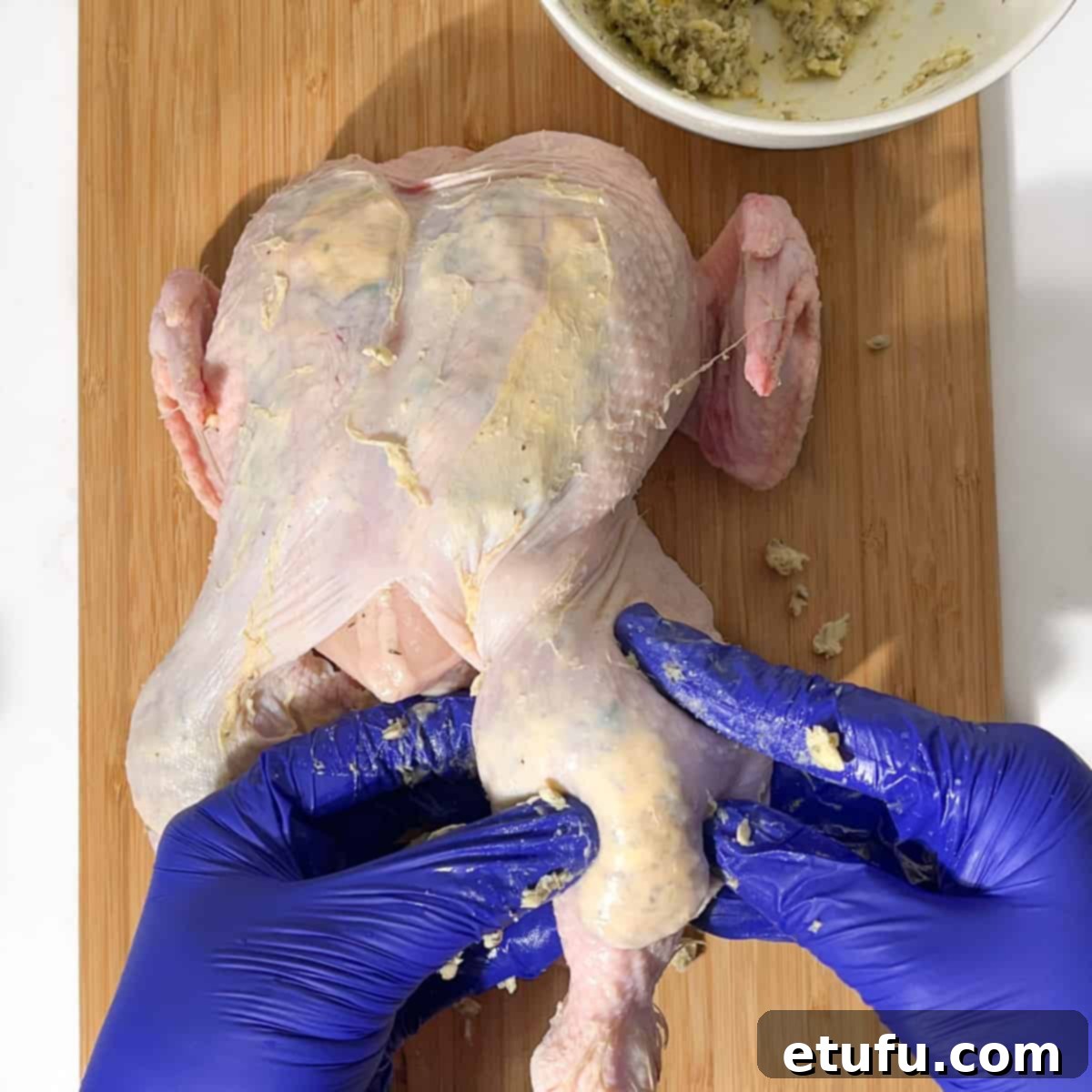
- Butter the Legs: Follow the exact same process for the chicken legs, pushing butter under the skin and then gently massaging it from the exterior to spread it thoroughly.

- Apply External Butter: Briefly warm the reserved compound butter in the microwave until it becomes slightly runny. Evenly pour this melted butter over the entire exterior surface of the chicken.
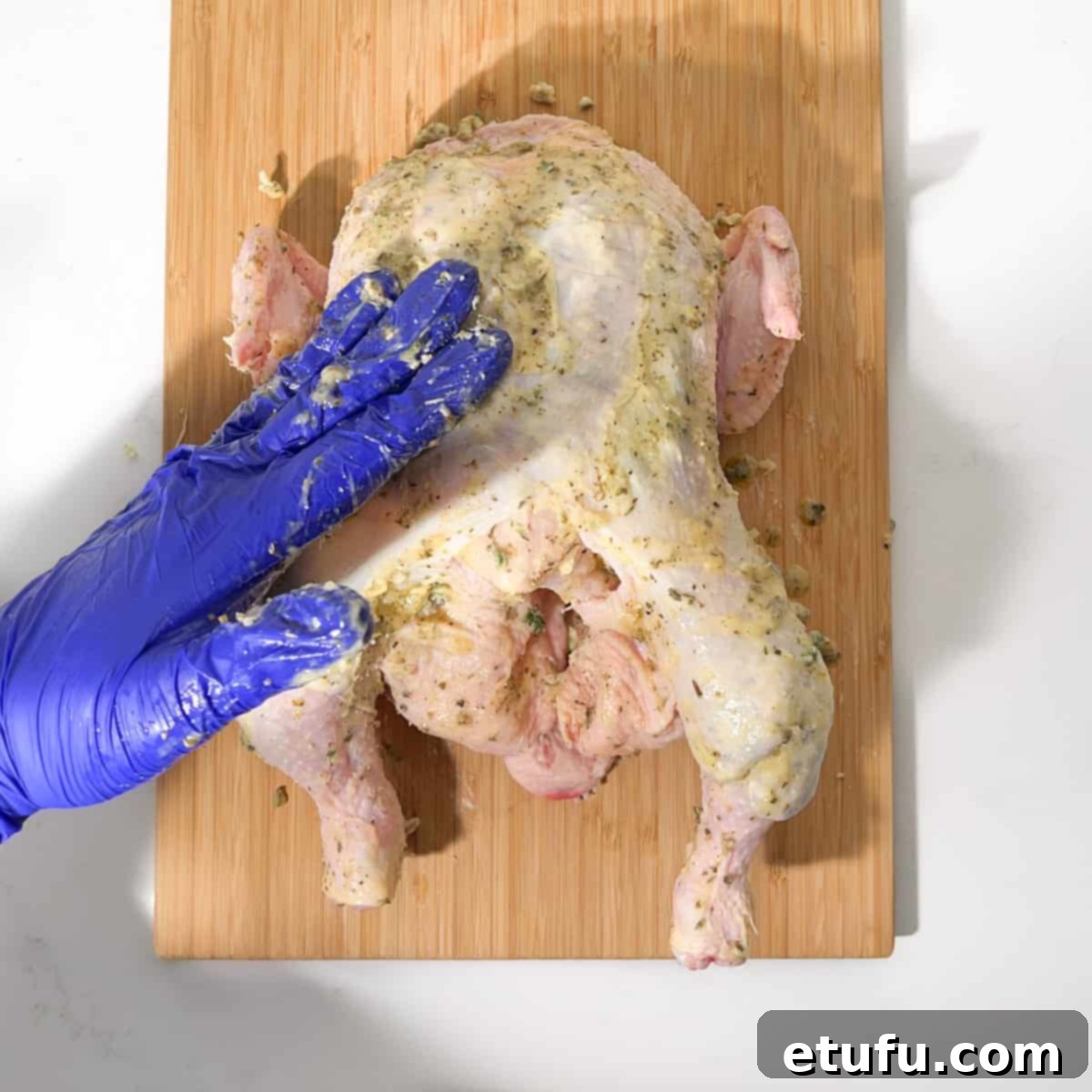
- Spread External Butter: Use your hands to thoroughly spread the butter all around the chicken thighs, legs, and body. (Remember to ignore the underside of the chicken for this step).
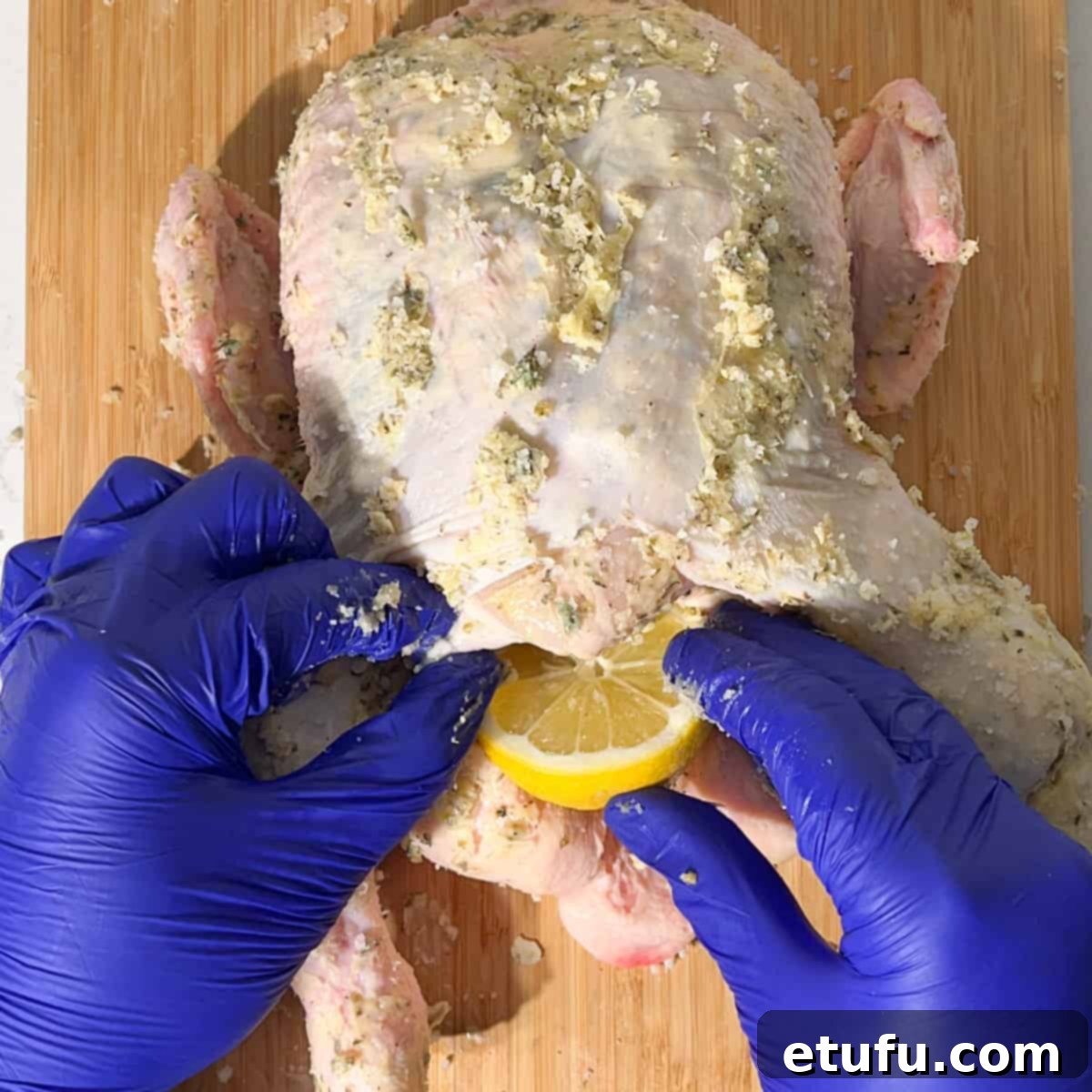
- Stuff with Lemon: Slice the fresh lemon in half. Take one half and firmly stuff it inside the chicken’s cavity. This will infuse the meat with a bright, zesty aroma.
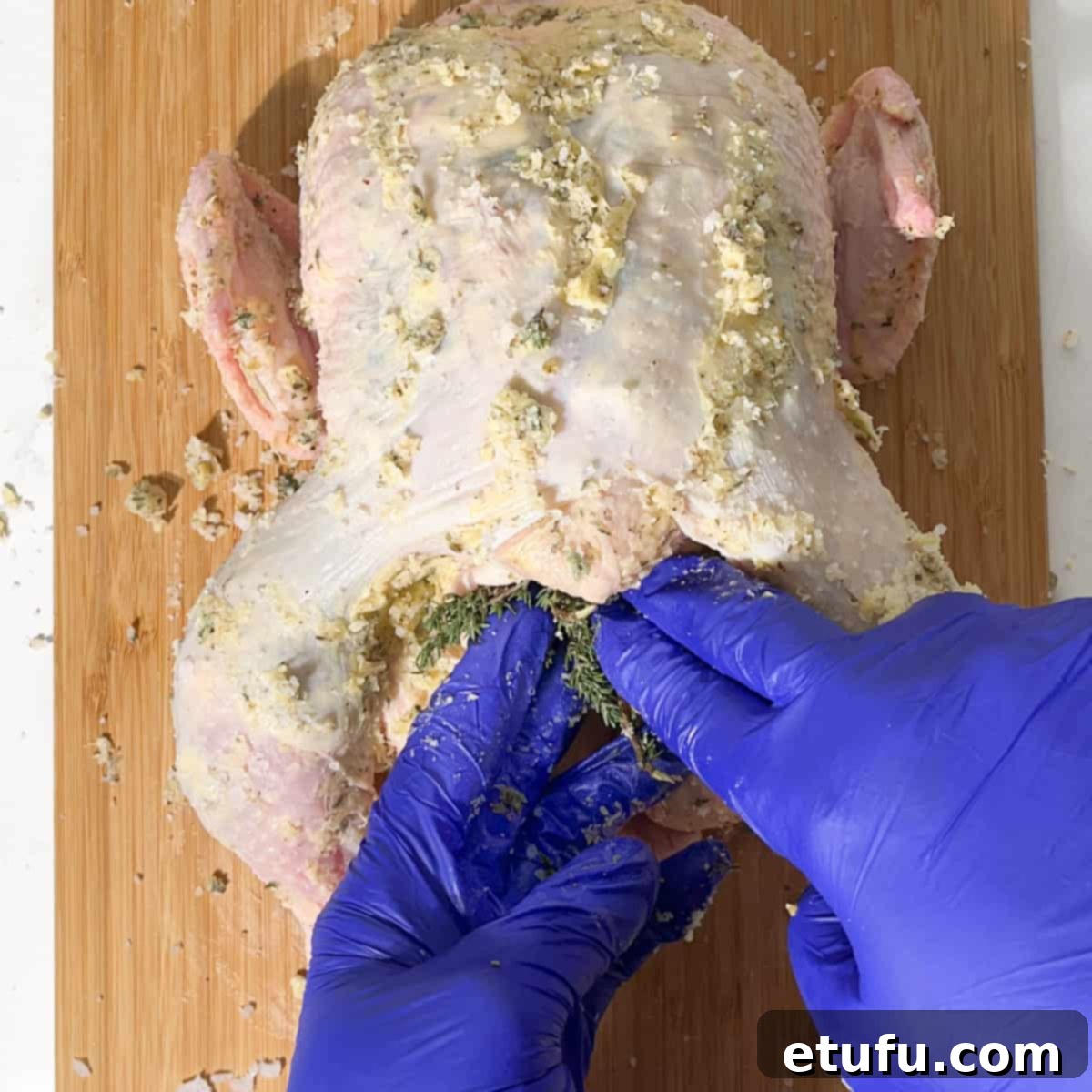
- Add Herbs to Cavity: Follow the lemon with a few sprigs of fresh thyme or rosemary, pushing them deep into the cavity to further enhance the chicken’s internal flavor.

- Optional Trussing: For a more compact shape and exceptionally even cooking, you can optionally truss the chicken’s legs together using a piece of kitchen twine. This technique ensures both breast and thigh meat cook uniformly.

- Season with Salt: Take a generous pinch of coarse sea salt and sprinkle it evenly across the chicken’s surface. We’ve found that a hearty three-finger-and-thumb pinch provides just the right amount of seasoning to draw out moisture and promote crispiness.
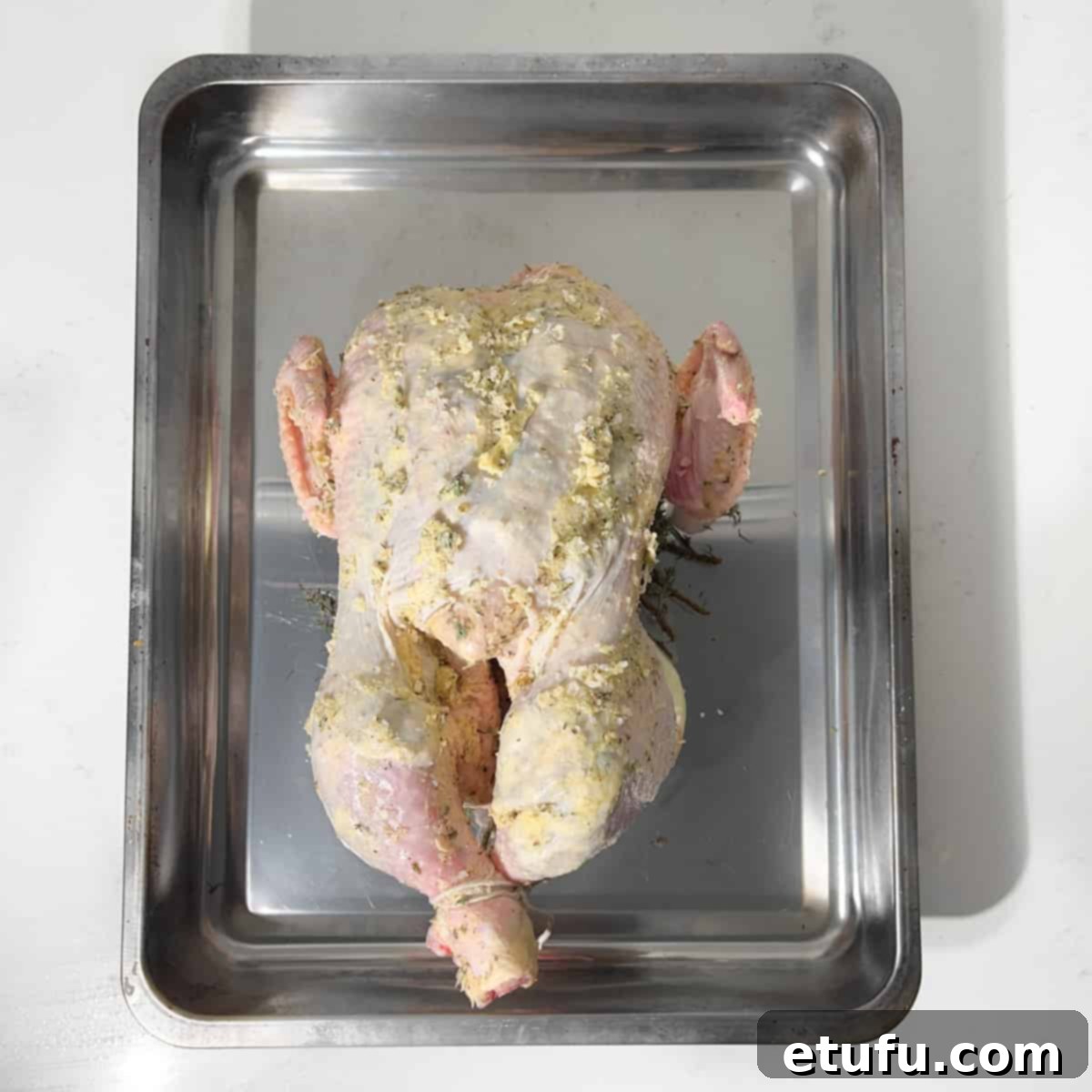
- Position on Trivet: Carefully transfer the prepared chicken onto its aromatic bed of onions and garlic in the roasting pan. Feel free to tuck a few extra sprigs of fresh herbs underneath the chicken for even more flavor if desired.
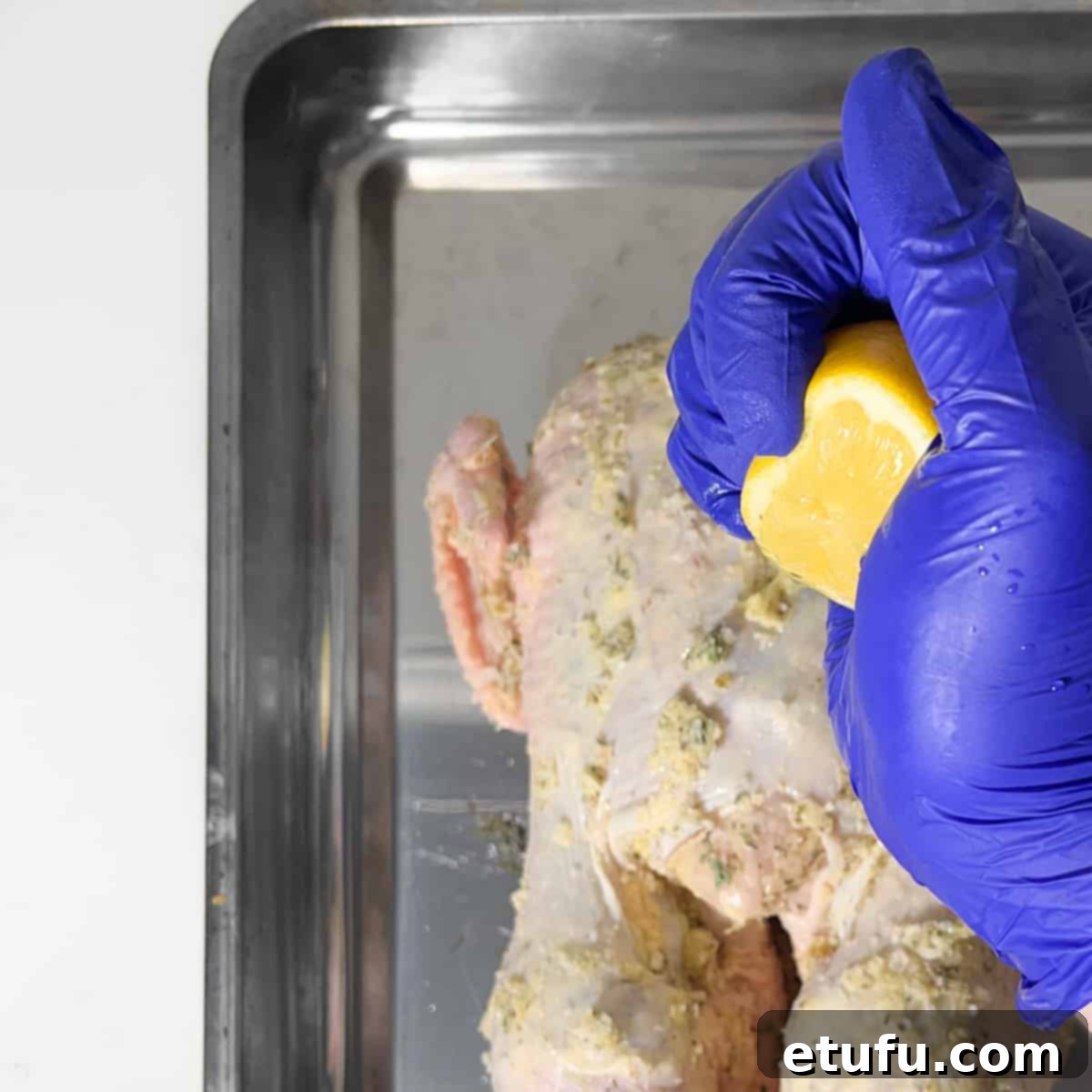
- Final Seasoning: With the remaining half of the lemon, lightly squeeze a small amount of juice across the chicken’s exterior, then finish with a generous grinding of fresh black pepper. (Crucial Note: Avoid over-drenching the chicken with lemon juice. Keep the liquid to an absolute minimum to ensure the skin remains crispy.)
- Roasting Process: Place the chicken in your preheated oven. Roast for an initial 10 minutes at the high temperature of 220°C (430°F). After this initial blast, reduce the oven temperature to 180°C (356°F). Continue roasting for an additional 20 minutes for every pound (approximately 450g) of chicken. The chicken is perfectly cooked when its juices run completely clear when pierced in the thickest part of the thigh. For precise results, an instant-read thermometer should register an internal temperature of 75°C (165°F) in the thickest part of the thigh without touching bone.
- Example: For a 1.9kg (4.2 lb) chicken: Cook for 10 minutes at 220°C/430°F, then reduce to 180°C/356°F and cook for an additional 84 minutes (4.2 lb x 20 minutes/lb = 84 minutes).
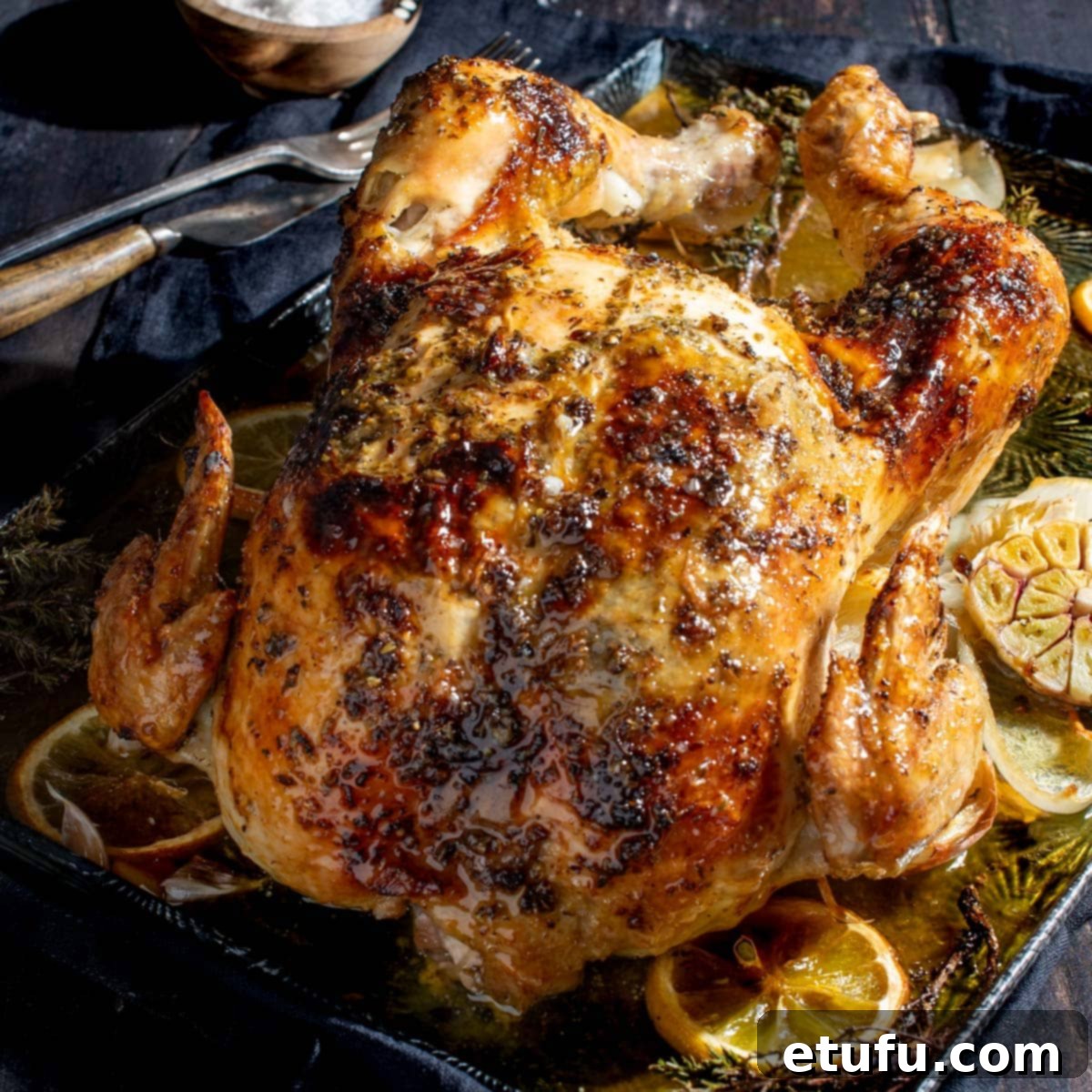
- Rest and Serve: Once cooked, remove the chicken from the oven and allow it to rest undisturbed for at least 15 minutes before slicing. Crucially, do not cover the chicken with foil during this resting period, as any trapped steam will soften the beautifully crispy skin you’ve worked hard to achieve. For an extra touch of gourmet presentation, you can brush a small amount of melted butter over the chicken just before serving to impart a lovely glossy sheen. For a truly Greek flourish, crumble over some feta cheese, scatter a few Kalamata olives, and arrange extra lemon slices around the platter.
Exciting Variations for Your Greek Roast Chicken
While our classic Greek roast chicken recipe is perfect as is, feel free to unleash your culinary creativity with these delightful variations:
- **Citrus Infusion:** Elevate the bright notes by incorporating a burst of additional citrus. Add finely grated zest from an orange, grapefruit, or even extra lemon into your compound butter mixture for a more complex aromatic profile.
- **Herb & Spice Exploration:** Experiment with a broader spectrum of fresh herbs! In addition to oregano and thyme, consider adding finely chopped fresh basil, parsley, or a touch of dill for nuanced flavors. Alternatively, streamline your seasoning with a pre-mixed Greek seasoning blend for convenience.
- **One-Pan Roast Dinner:** Transform your roast chicken into a complete, effortless meal by roasting an assortment of vegetables alongside it. Cherry tomatoes, colorful bell peppers, red onions, zucchini, or even chunks of sweet potato are fantastic choices that will absorb the savory pan juices.
- **Marinated Chicken:** For an even deeper flavor penetration, consider marinating your chicken for a few hours (or overnight) in a mixture of olive oil, lemon juice, garlic, and extra oregano before applying the compound butter and roasting. This pre-treatment adds another layer of moisture and tang.
Perfect Pairings: What to Serve with Greek Roast Chicken
A perfectly roasted Greek chicken deserves equally delightful accompaniments. Here are some superb serving suggestions to complete your Mediterranean feast:
- Crispy Roast Potatoes: Fluffy on the inside, golden and crunchy on the outside – the ultimate comfort food pairing.
- Easy Fried Courgettes (Zucchini): Lightly fried zucchini slices offer a tender, slightly sweet contrast to the savory chicken.
- Fresh Taboule: A refreshing and zesty bulgur salad with fresh herbs, tomatoes, and cucumber, perfect for balancing the richness of the chicken.
- 2-Ingredient Flatbreads: Simple, homemade flatbreads are ideal for soaking up all those delicious pan juices.
- Authentic Greek Salad: The quintessential side, combining ripe tomatoes, crisp cucumber, red onion, Kalamata olives, feta cheese, and a drizzle of olive oil.
- Simple Green Side Salad: A light, refreshing salad with a vinaigrette dressing provides a fresh counterpoint.
- Creamy Tzatziki: The cool, garlicky yogurt and cucumber dip is an absolute must for a truly Greek experience.
- Orzo Pasta with Herbs: A delicate pasta, often served simply with a touch of olive oil and fresh herbs, makes a wonderful side.
- Zesty Lemon Rice: Rice pilaf cooked with lemon juice and zest perfectly complements the chicken’s flavors.
- Roasted Sweet Potatoes: Cubed sweet potatoes roasted until caramelized add a lovely sweetness and texture.
- Spanakorizo: A traditional Greek spinach and rice dish, offering a hearty and nutritious green side.
- Wine Pairings: Pair your meal with a crisp, dry Greek white wine like a Retsina or an Assyrtiko from Santorini to enhance the Mediterranean flavors.
Storage, Reheating, and Freezing Your Leftovers
Maximizing the enjoyment of your delicious Greek roast chicken means knowing how to properly store, reheat, and even freeze any wonderful leftovers. Here’s a comprehensive guide:
Storing Greek Roast Chicken
To safely store any remaining Greek roast chicken, first ensure it has cooled completely to room temperature. This should ideally be done within two hours of cooking to prevent bacterial growth. Once cooled, carve the meat from the bone (or store whole pieces) and transfer it into an airtight container. Refrigerate promptly, where it will maintain its quality for approximately 3-4 days.
Reheating for Best Results
For reheating, the oven or a toaster oven is your best friend, as it helps preserve the precious crispiness of the chicken skin. Preheat your oven to 180°C (350°F). Place the chicken pieces on a baking sheet, ideally with a splash of chicken broth or water to maintain moisture, and cover loosely with aluminum foil. Reheat for about 15-20 minutes, or until the chicken is thoroughly warmed through. Remove the foil for the last few minutes if you want to crisp up the skin further. Avoid microwaving if possible, as it can make the chicken rubbery and the skin soggy.
Freezing for Future Enjoyment
To freeze Greek roast chicken, allow it to cool completely before portioning. You can freeze whole pieces or shredded meat. Wrap the chicken tightly in plastic wrap, then follow with a layer of aluminum foil, or place it securely in a freezer-safe airtight container. Don’t forget to label your container with the date for easy reference. Properly frozen roast chicken can be stored for up to 2-3 months without significant loss of quality.
When you’re ready to enjoy your frozen chicken, the best practice is to thaw it slowly in the refrigerator overnight. Once thawed, proceed with reheating instructions as outlined above for the freshest taste and texture.
Explore More Mediterranean Delights
If you’ve fallen in love with the vibrant flavors of the Mediterranean, we invite you to explore more of our cherished recipes:
Spicy Vodka Pasta
Cypriot Grain Salad
Easy Fried Courgettes
Traditional Taboule Salad
Creamy Italian Pasta Salad
Tunisian Orange and Almond Cake
Panzanella Toscana Salad
Recipe

Juicy Greek Roast Chicken with Garlic and Herb Butter
This simple, juicy roast chicken, with a crispy skin to boot, embodies all the familiar flavours of Greece. Infused with the classic combination of oregano and fresh, zesty lemon, it brings the essence of the sunny Mediterranean right to your table.
Print Recipe
Equipment
- 1 roasting dish
Ingredients
For the chicken
- 1 large, whole chicken – circa 1.9kg/4.5lb
- 1 large onion, quartered – no need to peel, just remove the dry outermost layer of skin
- 1 whole garlic head, halved horizontally
- 1 lemon, halved
- small handful of thyme or rosemary sprigs
- large pinch of coarse sea salt – or to taste
- freshly ground black pepper – to taste
For the compound butter
- 110 grams (1 x US stick) unsalted butter, softened
- 4 teaspoons garlic paste – or chopped, fresh garlic
- 1 tablespoon dried oregano
- 1 teaspoon fresh thyme, chopped – or rosemary, or their dried counterparts
- 1 teaspoon coarse sea salt
- ½ teaspoon freshly ground black pepper
Instructions
- Take the chicken out of the fridge approximately 30 minutes before you begin to allow it to come up to room temperature.
- Make a note of the weight of the chicken. You will need this to calculate the cooking time.
- To make the compound butter for the stuffing, add the softened butter, garlic paste (or chopped garlic), dried oregano, chopped thyme, coarse sea salt and black pepper to a bowl.
- Using a fork, squash and mix all the ingredients together until thoroughly combined. Set aside.
- In a large roasting dish, arrange the quartered onions and halved garlic heads to create a ‘bed’ for the chicken. See note 1
- Preheat the oven to 220C/430F.
- Remove the chicken from its packaging and place it on a layer of kitchen paper. Gently pat the entire bird bone dry with another piece of paper towel. This step is crucial to ensure a crispy skin.
- To make it easier to put the butter under the skin, loosen the skin from the bird first. Use a big spoon or spatula to gently slide between the flesh and the skin, separating it as you work your way around the top half of its body. Just be careful not to tear the skin in the process.
- Do the same for the legs. You should be able to find an entry point near the loose skin around the cavity entrance of the chicken. See note 2
- Set aside approximately a quarter of the compound butter. This reserved portion will be used for the outside of the chicken.
- From the remaining butter, pinch off about two teaspoons worth of compound butter with your fingers.
- Gently push the dollop of butter underneath the skin, moving it up towards the top of the chicken breasts. Follow with more dollops of butter until you’ve placed a few across the largest surface area of the chicken.
- Press down on the outside surface of the skin to gently massage the butter underneath, flattening and spreading it out slightly.
- Follow the same process for the chicken legs, pushing the butter in and then gently massaging it from the outside to spread it out more.
- Briefly microwave the butter you set aside earlier until it becomes a bit runnier. Evenly pour it over the outside of the chicken.
- Use your hands to spread the butter around the chicken’s body, thighs and legs (Ignore the underside of the chicken).
- Slice the lemon in half and stuff one half inside the chicken’s cavity.
- Follow the lemon with a few sprigs of thyme or rosemary, pushing them up into the cavity.
- Optional: Truss the chicken’s legs together with a piece of butcher’s string. See note 3
- Take a generous pinch of coarse sea salt and sprinkle it across the chicken. We’ve found that a three-finger-and-thumb pinch is just the right amount.
- Transfer the chicken onto its onion and garlic trivet. Feel free to add more fresh herbs below the chicken if you wish.
- With the remaining half of the lemon, squeeze a small amount of juice across the chicken, followed by freshly ground black pepper. See note 4
- Cook the chicken for 10 minutes at 220C/430F then turn the heat down to 180C/356F. Then, cook it for 20 minutes per every pound (450g) of chicken. Check that the juices from the chicken are running clear before removing it from the oven. See note 5
- Allow the chicken to rest for 15 minutes before slicing. Do not cover the chicken at this point because any steam trapped inside foil will soften the crispy skin.
Notes
Note 2: You don’t need to loosen the skin on the underside of the chicken.
Note 3: Trussing helps the chicken cook more evenly. By securing the legs together, you create a more compact shape, allowing for uniform cooking of both the breast and thigh meat.
Note 4: Avoid drenching the chicken with the lemon juice. Keep the liquid to a bare minimum to ensure a crispy skin.
Note 5: For example, a 1.9kg (4.2 lb) chicken will cook for 10 min at the higher heat and a further 84 minutes at the lower heat (1900g/450g = 4.2 x 20 minutes = 84 minutes). If you have an instant-read thermometer, chicken is done cooking when its internal temperature reaches 165ºF (75ºC).
**Nutritional data disclaimer**
Please keep in mind that the nutritional information provided below is calculated by a third party and we cannot guarantee the accuracy. We try our best to give you the most accurate information, but we do not take responsibility for errors that may be present. Also, the nutritional value of the recipe may change depending on the exact brands and products used. We recommend that you consult with a qualified healthcare professional or registered dietitian for personalised advice on your dietary needs.
Nutrition
For food safety advice, including guidance on food allergies
